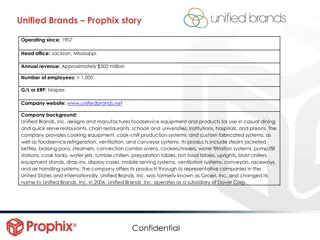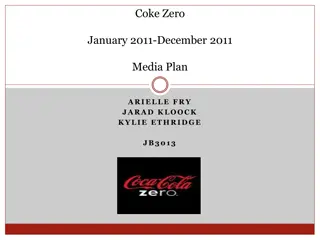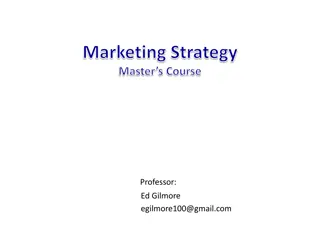Importance of Brands in Marketing Strategy
Brands play a crucial role in marketing by differentiating products, reducing consumer uncertainty, and providing reassurance on quality and origin. For manufacturers, brands lead to higher margins, while for consumers, they simplify decision-making and offer emotional benefits like prestige. Trademarks help consumers identify preferred brands and ensure consistent quality across various purchase channels. Overall, brands are essential for creating value and loyalty in the market.
Download Presentation

Please find below an Image/Link to download the presentation.
The content on the website is provided AS IS for your information and personal use only. It may not be sold, licensed, or shared on other websites without obtaining consent from the author. Download presentation by click this link. If you encounter any issues during the download, it is possible that the publisher has removed the file from their server.
E N D
Presentation Transcript
The 3i model Silvia Rita Sedita silvia.sedita@unipd.it
Definitions The most basic definition of a brand is that it is a name, term, sign, symbol, or design (or combination thereof) intended to identify the goods and services of a seller and differentiate them from the competition. A brand comes to embody elements of the product and the intellectual property (e.g. trademarks, patents, trade dress, wordmarks and design marks) that the brand uses to speak to the world. The brand can also be thought of as the embodiment of a promise from the manufacturer to the consumer, a communication of quality, product origin, integrity and consistency that a consumer can count on when purchasing a product that is sold under the banner of the brand, as signaled by the trademarked symbols. A brand and its trademarked markers can be defined as the unique property of a specific owner [that] has been developed over time so as to embrace a set of values and attributes (both tangible and intangible) which meaningfully and appropriately differentiate products which are otherwise very similar. The brand has the ability to reassure consumers as to the quality and origin and ... provide them with a kind of route map through what would otherwise be a bewildering range of alternatives . Source: Murphy, J.M, Brand Strategy, Cambridge: Director Books, 1990 Note: Here I use the term trademark to refer to any of the intellectual property associated with the brand, such as brand name and characteristic typeface, logos, word marks, package design, trade dress, or other patented features.
Why brands? For manufacturers Brands provide benefits to manufacturers by allowing for higher margins. For consumers Brands and their trademarked symbols provide benefits to consumers by helping them navigate or choose among brands and by providing reassurance about the quality, origin or other key characteristics of the product. Information search reduction Risks reduction Higher quality Emotional needs and prestige
Value for consumers Navigation Reassurance Trademarks or brands provide assistance in identifying their preferred brand. Brands provide the consumer with a way to make quick decisions about purchases. Regarding the origin and quality of consumers preferred brand. Trademarks communicate the intrinsic attributes of the product or service and reassure consumers that they have made the right choice Elimination of uncertainty Guarentee Particularly in products that do not have significant difference in features, the brand allows the consumers comfort in their choice. Shopping experience is less stressful Quality and consistency regardless of the circumstances or channel of purchase. A consumer knows that a trademarked product purchased online will be the same as one purchased at another online retailer, a retail store, or a mass merchandiser. Source: Elaborated on Joyce, 2013
Value for companies Price premiums International Expansion Consumers will pay more for the same product if it is branded. This value of a brand is created over many years of investment by the manufacturer. The Lacoste crocodile is worth $85 [when added to a shirt or other piece of clothing]. It took 75 years to create this value. A strong brand can make it easier for a firm to enter foreign markets because, even if consumers in the market have never tried the firm s products, they may be aware of its brand and even feel that they have some knowledge about the firm s products. Consumers in the United Kingdom are willing to pay more than 140 times more for Evian bottled water than they do for tap water. Consumers perceive bottled water to be purer and cleaner than tap water, despite the fact that tap water is generally more tightly regulated than bottled water and consumers generally cannot tell the two types apart in blind taste tests Source: Elaborated on Joyce, 2013
Co-branding When a brand name or logo is shared between two different products or services, it is referred to as a co-brand. The purpose of a co-brand is for both the primary product associated with the brand and trademark and the secondary product on which the brand and trademark are applied to both benefit from the brand equity that has been created for the separate brands. These co-branding alliances are valuable for both parties as the extend the perceptions and other dimensions of brand equity into a different category and, when successful, enhance each brand separately. There is an increasing use of co-branding in the fashion industry Source: Elaborated on Jean-Noel Kapferer, The New Strategic Brand Management: Advanced Insights and Strategic Thinking , 5th Edition, 2012. London: Kogan Page. Pages 166-170.
Co-branding https://www.youtube.com/watch?v=pyV57QlGUGI https://www.youtube.com/watch?v=pPviiyHvk7A&list=UUzcYyo1s 0WiFBzoCpQw4p_Q
The case of Bayer Aspirin Quality Bayer (%) Generic (%) provides rapid relief 53 24 alleviates muscle pain 49 22 reduces inflammation 42 28 provides lasting relief 41 26 valid for the treatment of acute pain 33 5 relieves arthritic pain 30 17 eases menstrual discomfort 9 18 cause gastric distress 11 14 easy to assume 62 48 good value for money 59 68 a modern brand 51 31 prevents heart attacks 41 19 recommended by doctors 37 16 Source: John Quelch (1997), Bayer AG (A) , Harvard Business School case #9-598-031
Brand power Despite the fact that Bayer aspirin and generic or store brand aspirins are identical in their formulation, consumers perceived Bayer aspirin to be more effective, easier to take, and faster- acting. As a result of these perceptions, the Bayer product was considered to provide good value for money by almost as many consumers as the unbranded product, despite a much higher price. Consumers therefore would choose Bayer from among the various brands offered. Source: Quelch (1997)
Packaging Packaging with its trademarked components plays an important in role in building and maintaining brand equity. Packaging is so important that marketers often think of it as a 5th P , to go with the traditional 4 Ps of marketing product, price, promotion and place (also known as channel. ) Source: Elaborated on Keller, Kevin Lane: Strategic Brand Management, 3rd edition, Upper Saddle River, NJ: Prentice-Hall 2008
Packaging For example, Absolut Vodka s distinctive bottle shape has been featured in more than 1,500 different print ads around the globe, as well as being recreated in such unusual media as a giant ice sculpture, a corn field, crystal and a designer dress. In 2008, the Absolut brand was the key asset acquired in the takeover of Vin & Spirit by Pernod Ricard for 20.8 times earnings (EBITDA*) Source Joyce (2013) *EBITDA Earnings Before Interest Taxes Depreciation and Amortization Colors and shapes on packaging can also be used to build upon the value of the brand. The term trade dress is used to describe the overall appearance of the package. Elements of trade dress include patented packaging design and trademarked graphics along with graphics, color and shape. http://www.absolutad.com/absolut_about/history/advertising/ http://carolinads.wordpress.com/absolut-vodka/
Brand extension Brand extension is a marketing strategy in which a firm marketing a product with a well- developed image uses the same brand name in a different product category. Organizations use this strategy to increase and leverage brand equity
Brand identity Brand identity Brand identity is the embodiment of how the company wants its brand or brands to be recognized by the consumer. A firm invests to build a strong brand identity because a strong and clear brand identity makes it easier for consumers to buy the firm s products instead of those of its competitors. A strong brand identity is one that builds a high level of brand awareness and recognition and helps to differentiate the brand in the eyes of consumers. is about positioning your brand in the minds of the consumers. Positioning must be relevant to the rational needs and wants of the consumers It includes brand names, patents and trademarks, logos and graphics, all of which help the consumer to recognize the product and associate it with the brand. Source: Adapted from Kotler et al. 2010
Trademark and logo A strong trademark or logo can identify a product and act as a sort of shorthand expression of the brand and its values, evoking the brand in the consumer s mind through just a glance. For example, consider the following graphic logos: Source: Elaborated on William Joyce, 2013
Trademark and logo The logos are much m The logos are much more effective and efficient communicators of brand values than the corresponding words Source: Elaborated on William Joyce, 2013
Brand image Brand image is about acquiring the consumer s heart share. brand value should appeal to consumer s emotional needs and wants beyond product functionalities and features. Brand integrity is about touching the spirit of the consumers It is about being credible, fulfilling your promise, and establishing consumers trust in your brand. Source: Adapted from Kotler et al. 2010
Differentiation According to Michael Porter of the Harvard Business School, differentiation is one of the generic strategies that a firm can use to gain a competitive advantage in the marketplace. Differentiation involves offering something that your competitors do not, such as superior service, higher quality or a distinct design. Differentiation serves two purposes it provides customers with a reason to choose the company's product over a competitor's it allows a firm to charge a premium price. Ultimately, consumers are willing to pay more for products they perceive as providing specific benefits that are lacking in competing products.
Positioning Placing a company or a brand (sometimes they are the same) in the consumer s mind in relation to the competition. For example, McDonald's positions itself as a low-cost, quick provider of meals, while a restaurant like Spago Beverly Hills provides high-quality meals in an upscale environment for a premium price. Products and services are positioned to meet the needs of different consumers, with the most successful offering multiple products that are positioned differently. For instance, the Holiday Inn operates hotels under various brands, such as Holiday Inn Express, which is positioned as a low-cost, no frills hotel, and Holiday Inn Select, which is positioned as an upscale, premium-priced hotel -- there's something for everyone who needs a hotel.
























